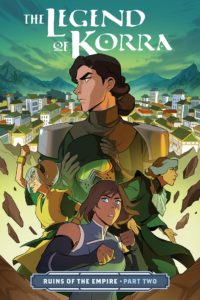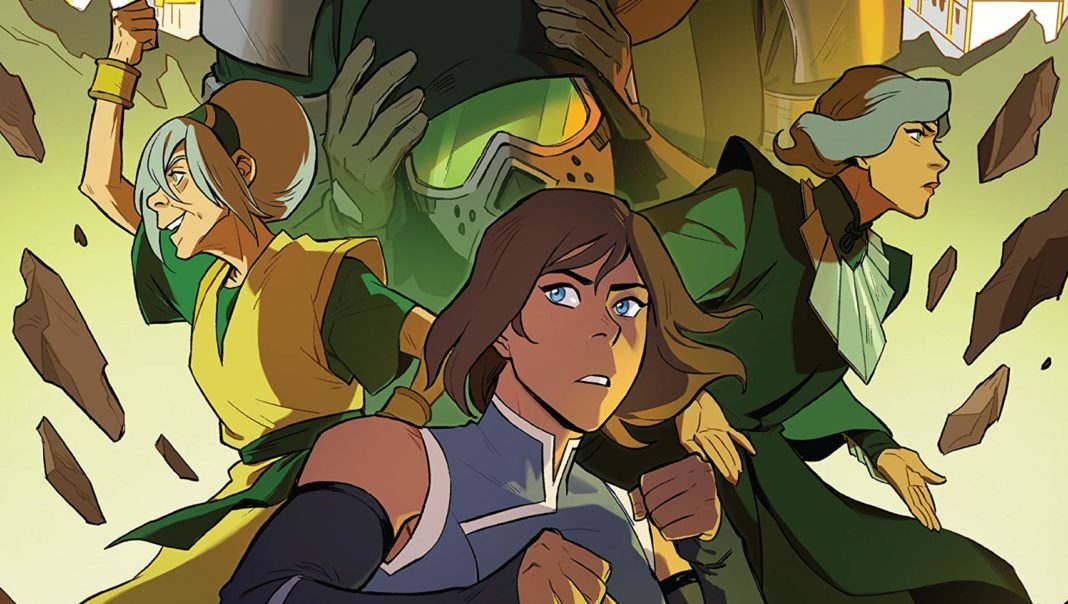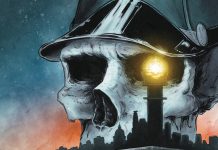By Amanda Steele
The Legend of Korra series continued the world of Avatar: The Last Airbender in many new and exciting ways. After the Korra animated series ended with four seasons, the story of Korra, her girlfriend Asami, and their world has continued in a series of comic books. The most recent is a trilogy called Ruins of the Empire, written by series co-creator Michael Dante DiMartino and illustrated by Michelle Wong. The first volume is available now, and the second volume will be available Nov. 12.
I got the chance to talk with Michelle Wong via e-mail shortly after this year’s New York Comic Con about her experience creating art for Ruins of the Empire and what it was like to continue Korra’s story.
Amanda Steele: When did you first get into doing art for comics? Did you read them as a child or teen?
Michelle Wong: I did read comics as a child — stuff like Garfield, Archie, and a Hong Kong manhua called Old Master Q. I got into superhero comics and manga as a teen, but I didn’t start drawing comics myself until I was about 21, when I realized, “Hey, I love this thing, why not try to do it for a living?”
Steele: When did you first discover a love and passion for art? You’ve done art for Goosebumps, Power Rangers, and Lumberjanes; what do you enjoy about working on a variety of projects?
Wong: I used to never pay attention in school unless there was an art lesson involved, so I have always loved to draw — but I wasn’t always sure about art as a career. There was a time when my lack of confidence led me to leave it behind, but I found that I wasn’t happy unless I was creating. It’s still funny to think that I do get to work on all these projects now, and I love that there has been such a variety. I get to entertain a lot of my interests, from horror to fantasy to superhero action, and that keeps things exciting.

Steele: The Legend of Korra, along with Avatar: The Last Airbender, is an extremely popular franchise. How has it been working on a series with such a big fan base and continuing on the story of Korra?
Wong: Not gonna lie, it was super intimidating at first. Knowing that there is such a big fan base, the last thing you want to do as a creator is to let them down. Not to mention that with so many talented people working on this series before me, there were certainly some big shoes to fill. I’ve had to push myself a lot on this series, but it’s been very rewarding.
Steele: Where you a fan of the series before you started working on Ruins of the Empire?
Wong: I watched the series when it came out, but working on Ruins has made me appreciate it more. When I got the job, I went back and rewatched a lot of the episodes and found myself paying attention to things that I hadn’t thought about at first, like all the different character nuances going on in a scene, or just how imaginative some of the fighting sequences are.
Steele: What is the collaboration process with Michael Dante DiMartino like?
Wong: Our process is pretty streamlined, and most of our communication is done through email via our editors. Most of the back and forth happens during layouts — if I have questions I will write notes on the pages, and Mike might send back a diagram or specific reference to solidify the point. I will receive a few lines of feedback when I turn in lineart, but usually just for minor changes.
Steele: What is your process for creating the artwork for Ruins of the Empire?
Wong: I start with layouts for the whole book after going through the script a couple of times. I like writing down notes and drawing stick figures in the margins while reading, especially if there is a specific shot that I think will work well. The stick figure drawings eventually get cleaned up to make sure my editors can tell what’s going on. Once layouts are approved, I move onto pencils — since I’m doing the lineart myself, my pencils tend to be very loose and I’ll do the bulk of the drawing in inks. Then the lineart is handed off for [colorist] Killian Ng to work their magic on.
Steele: Do you have a favorite panel or page?
Wong: It’s so hard to choose a favorite! I’ll just pick one that I like. In Volume 2, there is a panel where King Wu gives Toph a hug, and she is very unimpressed, and I loved drawing that.
Steele: Are there any particular characters or scenes that you love working on?
Wong: I like working on the funnier scenes with Toph, and Kuvira’s flashbacks. I also love drawing Asami, because her design is just so gorgeous.
Steele: There are quite a few fighting sequences. How do you convey the movement and excitement of these scenes? What is your process for that?
Wong: I try to aim for a snapshot that will convey action without sacrificing clarity. Story comes first, and if readers are immersed, that already helps with the excitement. There’s also panel layout to consider. In comics, you get to make use of panel shape and space to emphasize a moment, which is one thing animation doesn’t have, and I try to take advantage of that. Since bending is the main attraction of this universe, I also spend a lot of time going through the “bending bible” when planning out fight sequences — it’s a collection of short videos and stills created by Nickelodeon to show all the different styles of bending, and it’s a lifesaver.
Steele: One thing that many people love about The Legend of Korra is the diversity in the series, especially the inclusion of an LGBT couple with Korra and Asami. How has it been working on a comic that has such diverse characters? Can you talk about the importance of that?
Wong: I’ve been fortunate enough to be given projects all featuring diverse casts in my career, and it’s always nice to work on something that reflects my own life experiences. I think everyone belonging to an underrepresented group knows how much it means to see yourself in works of media, and to know that there are other people like you, that they belong, and they’re worth looking up to. With Korrasami in particular, all the support for them has been inspiring. I did not get to grow up seeing LGBT characters in cartoons, or even many characters resembling myself in Western media. It makes me happy to know that things are changing and to be a part of that change.
Steele: In a panel at New York Comic Con, you mentioned how fan input has inspired you to include more moments between Korra/Asami. Can you talk more about The Legend of Korra fandom and what interacting with fans is like?
Wong: The fans have been so warm and enthusiastic, and getting to talk to some of them at NYCC was definitely a highlight in my career! Though I try not to dig too deep into reviews and such, I do very much know what it’s like to be a fan and to be so deeply, lovingly invested in something. So when someone gets excited about Korrasami in the comics I can’t help but want to acknowledge them, like, yes! Me too! Most of their important moments are already there in the script, but if I can add a little extra hand-holding or casual touches here and there, I will definitely try.
smoochy pic.twitter.com/VDzqW6lxaG
— Michelle Wong (@lokhelle) January 21, 2019
Steele: What else are you working on? Are there any other projects you would like to spotlight?
Wong: I have been working on some original projects in my spare time, but for now the Korra comics are my main focus.
Steele: Although I’m sure you don’t want to spoil it, is there anything you can say about Part 2 of Ruins of the Empire and beyond?
Wong: I hope you all like some angst!
The Legend of Korra: Ruins of the Empire, Part 2 hits shelves Nov. 12 from Dark Horse Comics. To keep up with Michelle Wong on social media, follow her on Twitter @lokhelle. You can also visit her website, wlokhelle.com, or her shop.








